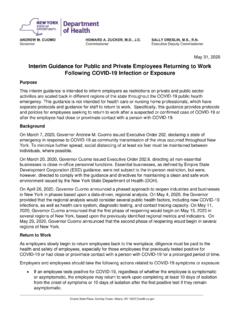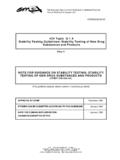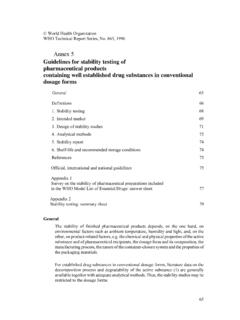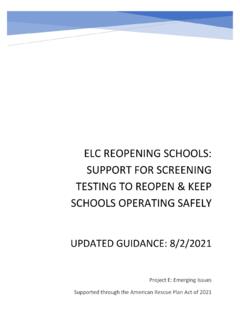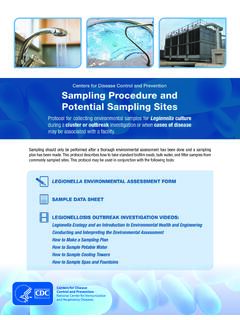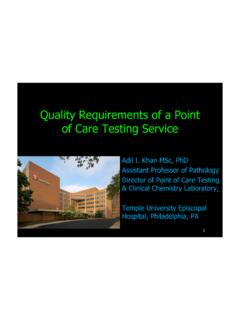Transcription of COVID-19 Testing How to Isolate or Quarantine: Next Steps
1 LCOVID-19 TestingNext StepsYou are being tested for a virus that causes COVID-19 . If you have symptoms of the disease, or if you have been in contact with someone who is infected, you will be asked to stay apart from others. This is also called isolation or quarantine . COVID-19 spreads easily. Staying apart helps stop the disease from Include:Fever, cough, di culty breathingOther symptoms may include: chills, muscle aches, headache, sore throat, abdominal pain, vomiting, diarrhea, runny nose, fatigue, wheezing, or new loss of taste or Should Be Isolated If: You have symptoms and think you may have been infected with the Should Be Quarantined If: You have been in close contact with someone known to have COVID-19 , even if you don t have symptoms.
2 Close contact means sharing the same household, direct physical contact, or being within six feet for more than 10 back for more ResultsYou will be contacted with your you test positive on a diagnostic test for the virus, you must continue isolation. You will get a call from a public health representative to identify any contacts you have you test negative, but you have been in close contact with a person known to have been infected, you must still continue quarantine until 14 days have passed from your last contact with a person known to have COVID-19 . Even though you may feel well now, you are at risk of getting the disease and you may get sick.
3 It can take up to 14 days to get the local health department can help you determine when it is safe to stop isolation or quarantine . Find them at Learn more at and Job AssistanceAny New Yorker under a mandatory or precautionary order to stay home may be eligible for job-protected sick leave and compensation. Learn more at you need help caring for yourself or your children while in isolation or quarantine , call your local health department. Find them at to Isolate or Quarantine: Stay home, except to visita you must see a doctor,call ahead and avoid using public transport such as subways, buses, t have yourself in a room that is not shared with others.
4 Stay at least 6 feet away from others at all a separate bathroom, if possible, and disinfect after each for food, medicine, and other supplies to be left at your your coughs and sneezes. Throw away used tissues. Bag your trash and leave outside your t touch for others to care for your children, if a face mask if you mustbe around your hands often with soap and water for 20 seconds each time, or if unavailable, use hand sanitizer with at least60% You are anEssential Worker:You can ONLY return to work while you wait for your test results if: You have your employer s permission to do so. You DO NOT have symptoms. And you have NOT had contact with a person known to have COVID-19 .
5 In addition, you must continue to: Practice social distancing (stay more than 6 feet from others). Use appropriate personal protective equipment (PPE). Wear a mask when less than 6 feet away from others in public. Take your temperature and monitor your symptoms apart now. Be together ResultsYou will be contacted with your you test positive on a diagnostic test for the virus, you must continue isolation. You will get a call from a public health representative to identify any contacts you have you test negative, but you have been in close contact with a person known to have been infected, you must still continue quarantine until 14 days have passed from your last contact with a person known to have COVID-19 .
6 Even though you may feel well now, you are at risk of getting the disease and you may get sick. It can take up to 14 days to get the local health department can help you determine when it is safe to stop isolation or quarantine . Find them at Learn more at and Job AssistanceAny New Yorker under a mandatory or precautionary order to stay home may be eligible for job-protected sick leave and compensation. Learn more at you need help caring for yourself or your children while in isolation or quarantine , call your local health department. Find them at York State Department of HealthOverHow to Isolate or Quarantine: Stay home, except to visita you must see a doctor,call ahead and avoid using public transport such as subways, buses, t have yourself in a room that is not shared with others.
7 Stay at least 6 feet away from others at all a separate bathroom, if possible, and disinfect after each for food, medicine, and other supplies to be left at your your coughs and sneezes. Throw away used tissues. Bag your trash and leave outside your t touch for others to care for your children, if a face mask if you mustbe around your hands often with soap and water for 20 seconds each time, or if unavailable, use hand sanitizer with at least60% You are anEssential Worker:You can ONLY return to work while you wait for your test results if: You have your employer s permission to do so. You DO NOT have symptoms. And you have NOT had contact with a person known to have COVID-19 .
8 In addition, you must continue to: Practice social distancing (stay more than 6 feet from others). Use appropriate personal protective equipment (PPE). Wear a mask when less than 6 feet away from others in public. Take your temperature and monitor your symptoms daily.





